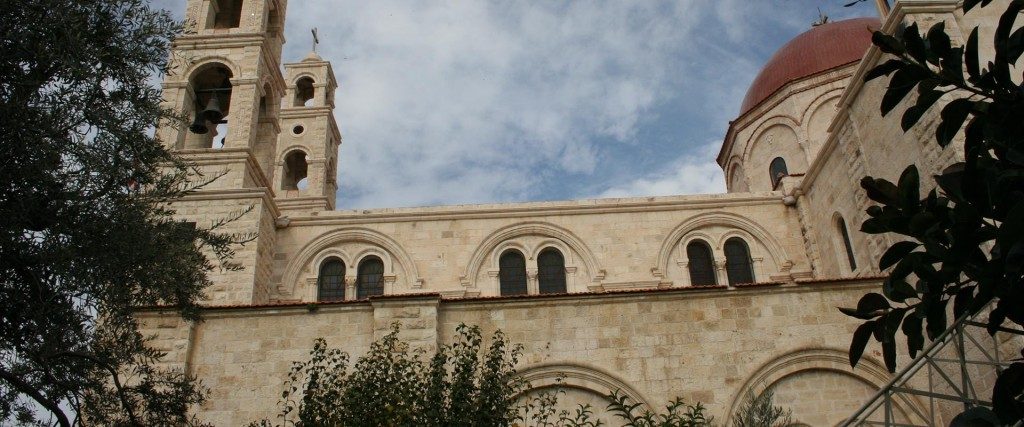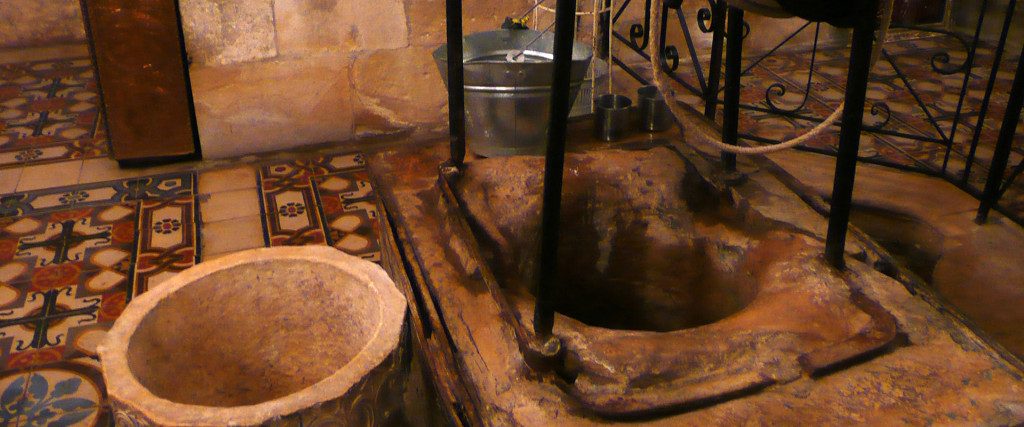7 A Samaritan woman came to draw water, and Jesus said to her, “Give me a drink.” 8 (His disciples had gone to the city to buy food.) 9 The Samaritan woman said to him, “How is it that you, a Jew, ask a drink of me, a woman of Samaria?” (Jews do not share things in common with Samaritans.)[b] 10 Jesus answered her, “If you knew the gift of God, and who it is that is saying to you, ‘Give me a drink,’ you would have asked him, and he would have given you living water.” 11 The woman said to him, “Sir, you have no bucket, and the well is deep. Where do you get that living water? 12 Are you greater than our ancestor Jacob, who gave us the well, and with his sons and his flocks drank from it?” 13 Jesus said to her, “Everyone who drinks of this water will be thirsty again, 14 but those who drink of the water that I will give them will never be thirsty. The water that I will give will become in them a spring of water gushing up to eternal life.” 15 The woman said to him, “Sir, give me this water, so that I may never be thirsty or have to keep coming here to draw water.” [John 4:7-15, NRSV]
 The Greek Orthodox St. Photini Church at Bir Ya’qub
The Greek Orthodox St. Photini Church at Bir Ya’qub
Jacob’s Well is in the Palestinian controlled area of West Bank. It is situated a short distance from the biblical Shechem, the archeological site of Tell Balata in the Samaria, and now part of Nablus metropolitan area.
A Greek Orthodox Church which is part of a monastery complex, stands over the Well. Access to the Well is by way of a flight of stairs to the crypt below.
In terms of religious significance, the four religions – Jewish, Samaritan, Christian, and Muslim – all associate the Well with Jacob. Jacob was the patriarch who was given the name Israel after he “wrestled with the angel” (Genesis 32:28 and 35:10). Descendants of Jacob came to be called Israelites. These eventually formed the Twelve Tribes of Israel descended from the 12 sons of Jacob and his two wives, Leah and Rachel, and two maidservants, Zilpah and Bilhah. They ultimately formed the kingdom of Israel, and from there came the name of modern-day State of Israel.
Considered one of the most authentic sites in the Holy Land, Jacob’s Well is 41 meters (135 feet) deep and is a working well. The caretaker of the place held us spellbound in a demonstration by pouring a dipper of water into the well, urging us to keep silent while we waited for the sound of the splash when the water hit bottom. When the distant-sound of splash was heard, we all uttered in unison a sigh of shocked-amusement, for it sounded “so deep”.
With unveiled delight and amazement, many of us took turns to wheel up a bucket of water, and everyone took a drink of the crystal clear and clean spring water from this ancient well. As we did so, we remembered Jacob and the love of his life Rachel, and Jesus and the Samaritan woman who gave him a drink and then asked him for his living water.
Reflection:
For most all of us in the group, this visit to Jacob’s Well was one of the highlights in our pilgrimage to the Holy Land and we were truly grateful for its inclusion in the itinerary.
For ourselves in particular, our minds kept pulling back to the two biblical stories, one each in the Old and the New Testaments, of Jacob and Rachel (Genesis 29), and of Jesus and the Samaritan Woman (John 4).
Jacob and Rachel
Jacob first met Rachel at a well at noon time (Genesis 29:1-28).
He did not win her immediately.
Instead, Jacob had to work hard to finally gain Rachel as his wife.
It took some doing, fourteen years of hard work to be exact for Rachel’s father to finally relent and let Jacob marry Rachel. Jacob knuckled down and did it. Rachel would become the love of his life and the mother of the children he dotted on.
The first seven years were a trick from Laban who broke his promise and gave not Rachel but her elder sister to Jacob under the cover of the night. Determined, Jacob stayed on Laban’s land to work another seven years in exchange for Laban’s consent to give Rachel to him for marriage.
Jacob’s determination is remarkable.
Equally remarkable, and current church regulations notwithstanding, is the fact that in Jesus’ ancestry, Jacob had two wives (and two maidservants as concubines) and it was considered perfectly fine. That, too, is biblical, which teaches us not to be too “dogmatic” in our approach towards other people who are caught in circumstances (and traditions) we today so dismissively label as “irregular” relationships.
From Pope Francis, we must also learn to listen to their stories before throwing the law books at them.
Pope Francis has learned well from the Lord Jesus, that is, to consider the human person ahead of the law.
- If we listen to Christ and his vicar Francis today, we too may indeed learn to be slow in judging those, but quick to show them compassion and mercy, to whom life has dealt a tough and often rather undeserved and “unjust” card.
Jesus and the Samaritan Woman
Jesus also met a Samaritan woman at Jacob’s well at high noon (John 4:1-42).
John’s Gospel speaks very early of Jesus’ return to Galilee, passing through Samaria. Tired from the journey, he stopped at noon for a rest by a well, his disciples sent off to buy lunch, and a Samaritan woman who has had five husbands and was now cohabiting with the 6th man, approached to draw water. Coming out at noon, she was apparently avoiding other women. Jesus asked for a drink and the encounter began. Against all the taboos, a Jewish man spoke to a Samaritan woman, even asked her for help.
Jesus “had to pass through Samaria”, St John wrote (John 4:4). But that was neither geographically nor politically true, so that what St John is pointing to is a “divine necessary” so that Jesus would encounter this woman in Samaria. Following from that encounter, she would be set free, and the town would be evangelized, first by her, a woman, and a despised one at that. It was divinely necessary that the Good News be preached in Samaria as well. And Jesus saw to it that a woman whom others considered a sinner would be the first to preach it.
Jesus’ attitude to women and people of other religions was clearly inclusive and non-judgmental.
The fact that on the one hand, the disciples who returned from town with their lunch were at first scandalized and were corrected by Jesus and yet, on the other hand, the early oral tradition of the Church had preserved this embarrassing bit of detail and included it into written Scripture, suggests that the lesson was well-learned by the disciples. They remembered what the Lord taught them and recounted the event and the lesson despite the embarrassment.
- God has a way of honouring women even when men throughout history have for self-interest sought to put women down and to trample on their God-given equality.
Drawing from St Teresa of Avila
Sr. Wendy Beckett, drawing from the spiritual wisdom of St Teresa of Avila, has written this reflection:
- St Teresa of Avila saw the well and its waters, Jesus and his interior waters, our thirst and his desire to give, as images of prayer. Yet grace cannot fill those dry reaches of our spirit unless we ask for it. The asking is precisely what we mean by prayer. It can be spoken, asking: “Lord, give me this water…”, as the woman prays, or it can be an unspoken need, a looking at God that expresses silently all our longing. Longing need not be emotionally experienced. It is sometimes an act of the will, accepting that we are far from what God wants us to be, even from what we want ourselves to be, and acknowledging that the grace of God can transform us. But we must take time to let the grace shine on us, to let the water seep within.
Copyright © Dr. Jeffrey & Angie Goh, January 2020. All rights reserved.
You are most welcome to respond to this post. Email your comments to jeffangiegoh@gmail.com. You can also be dialogue partners in this Ephphatha Coffee-Corner Ministry by sending us questions for discussion.

